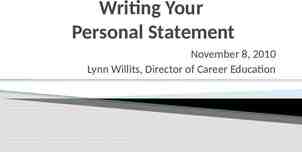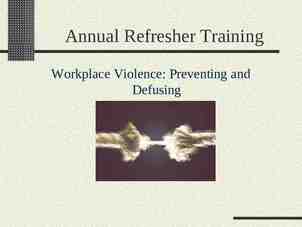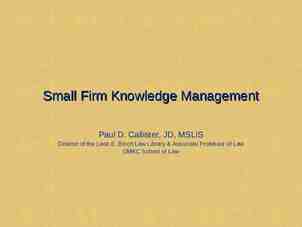A Vision for Improving Diversity, Equity, Inclusion, and Belonging
19 Slides849.84 KB
A Vision for Improving Diversity, Equity, Inclusion, and Belonging at Yale
The Yale Mission “Yale is committed to improving the world today and for future generations through outstanding research and scholarship, education, preservation, and practice. Yale educates aspiring leaders worldwide who serve all sectors of society. We carry out this mission through the free exchange of ideas in an ethical, interdependent, and diverse community of faculty, staff, students, and alumni.” Student demographics are changing to better reflect national demographics. Staff demographics have also changed, although not as much. Faculty demographics are nearly stagnant over the past two decades. 2
The Connection of Diversity and Excellence Improving faculty diversity is expected to impact learning and research at Yale and beyond Increases student retention and persistence in fields of study Research shows more diverse faculty tend to increase global issues considered for research and teaching. Students exposed to global issues are more likely to engage (higher attendance and achievement) and are twice as likely to take personal social action on such issues after graduation Education within a diverse setting better prepares students to be good citizens in an increasingly complex, pluralistic society Decades of research by organizational scientists, psychologists, sociologists, economists and demographers show that socially diverse groups are more innovative than homogeneous groups 3
Diversity, Inclusion, and Equity What are we looking for to improve faculty diversity? People with differing opinions, social experiences, political and religious beliefs, heritages and life experiences is what improving diversity adds to our research, teaching and service Increasing the range of racial, ethnic, dimensions of dis/ability, socioeconomic, geographic, gender, gender identity, sexual orientation, veteran status and national origins acknowledges societal forces 4
From the National Academies Press “ we must continue to drive bias, discrimination, and harassment out of our institutions and society. Despite decades of research, funding, and programs dedicated to increasing the representation of women in science, engineering, technology, mathematics and medicine, the numbers, particularly in leadership roles, have remained low or stagnant in many fields, particularly among women of color.” “The bulk of evidence that underrepresentation of women “These factors are indicates often experienced more overtly and in STEMM is driven by aofwide rangeidentities, of structural, intensely by women intersecting such as cultural, women and institutional patterns bias, discrimination, inequity that do not of color, women of with disabilities, and LGBTQIAand women” affect men of comparable ability and training ”
The Challenge of Achieving Diversity Why is this not the “natural” picture of academic faculty? Why focus on diversity rather than inclusion? e l p o e p , L s ackonolabeling/bucketing a Focuses e d i f succ of ess ov erthan Emphasizes differences rather deccommonalities ades o n o i t s f t ry i n u a h g Defiance/backlash Ex Success can be counted as assimilation, not pluralism 6
Studies Indicate the Problematic Cultural Patterns Limiting Inclusion and Diversity You cannot simply launch programs and expect results. Leaders still underestimate the challenges BIPOCs face.
Comments or Questions? 8
What Change Is Indicated/Warranted? Studies find that the leading causes for barriers to improvement of faculty diversity are: Belief in pipeline paucity even though it does not fully explain the lack of progress (U. of California studies) A sense of isolation for underrepresented faculty resulting from or leading to Lack of mentoring Devaluation of “minority research”, particularly in strongly interdisciplinary fields The “token hire” misconception among URM faculty Biases in tenure and promotion evaluations 9
One Example Set: Cultural Changes Needed Around Recruitment ) dies u t s a i n r o f i l . o f Ca U ( s d l e fi M “I totally support diversity and inclusion, ss in STE but the pipeline in e r g o r p f o k c la in the a l p x e y l l u f thiscitfield is too small to do it.” ot n s e o d y u ssible. o p y t i Pipeline pa s r e iv makes d d n a y it v ti produc diversity versus s e v o r “How are we supposed p to balance im clusion in , n o ti a v o ses inn a e r c excellence?” in y t i s Diver t list? a h t n o n e m 4 wo “We don’t d have a problem with hiring women - we, like any nt? n a 3 d n a 2 s r e b e differe the numdepartment, would jump at the chance to w e r a y h w Who areother – s and field hire s e iti s r e v i n u umerous n s s o r c a Professorowxxxx.” e c n his evide t h s s ie nted d e u s t e s r s p u e o r r r e e d m n u N es that u u s is o t g in n e st ole in liracism r t n a t r o with.of our p “Where is the evidence y f of structural in any im ti n n e a d y i t la o p n o y they ma faculty als t a e l h t a y m lt fe u c d a n f a it y actions?” to other Minorpast p u g in r b o t nlikely students are u
The Challenge of Achieving Diversity Why is this not the “natural” picture of academic faculty? Most people in from positions of influence theyfrom do not suffer Recent studies psychologists andthink reports URM’s from showbias bias and how it works in the workplace Lack of awareness ofresults how systemic bias in bias/racism a cultural and Systemic bias today from systemic of the historic context past – hiding the connection is part of the system We are all on aware career paths resulting inwithout Insistence use of unusual biased measures of productivity remarkable achievements yet we remain risk averse corresponding measures of–value/worth 11
Some Findings from the President’s Committee on Diversity, Inclusion and Belonging Strengthen inclusion and a sense of belonging
Some Findings from the President’s Committee on Diversity, Inclusion and Belonging Need a work culture of greater respect
Comments or Questions? 14
Focus of the Work Ahead Faculty diversity efforts are the greatest need, but diversification of campus community should be a goal Review and adopt a framework for assessment Deepen a culture of respect and connection Articulate, promote, and socialize DEI and belonging in fulfilling the University’s mission All academic and administrative units should develop local DEI and belonging plans with specific direction to address the needs of BIPOC staff, faculty and students
Effective Strategies for Change Avoid the bias to undue action – Heidi Brooks, Yale SOM “Reflect on your own culture and power dynamics and create a long-term plan for impact”
Change Can Be Rapid
Effective Strategies for Change Lean into climate surveys and departmental self-assessment (we can help but look to your peers as well) Leaders need to lead Particularly on hard discussions about race, gender, inclusion Leaders set the culture for deciding on your core values Empower ugrad/grad students/staff/Asst. Profs to dialogue Restructure your committees Diversify representation Seek to engage groups most impacted by decisions of a committee Broaden the leadership pool
Examples of Best Practices for Change Expand networks for recruitment, advice, and scholarship Faculty search and graduate recruiting committee chairs and members should reach out to colleagues at institutions that have diverse faculty and students to identify high-potential female and underrepresented minority candidates Advertise broadly, including to interest groups with diverse faculty audiences Use outreach efforts to promote Yale’s interest Review and revise policies that affect equity and inclusion Look particularly at means of communication – promote transparency Distribute decision-making as much as feasible – establish a climate committee Work to recognize and acknowledge contributions of everyone in your dept Keep to plans for which you have a means of assessment of progress compared to expectations and accountability for progress.
























